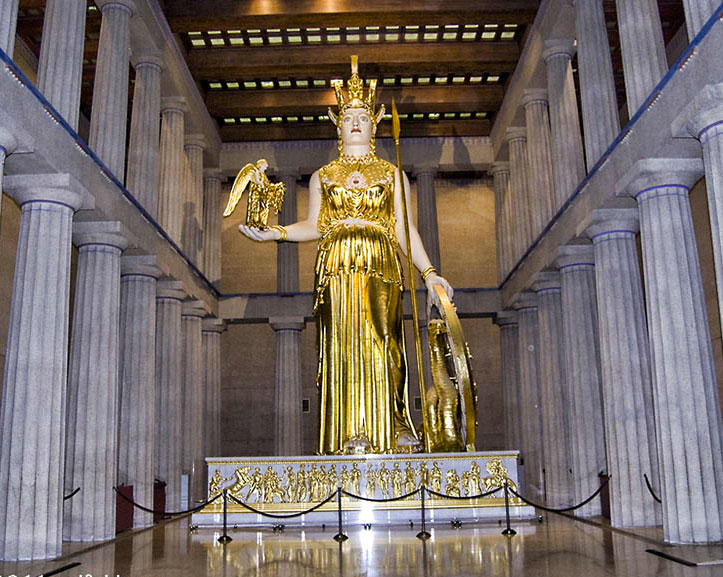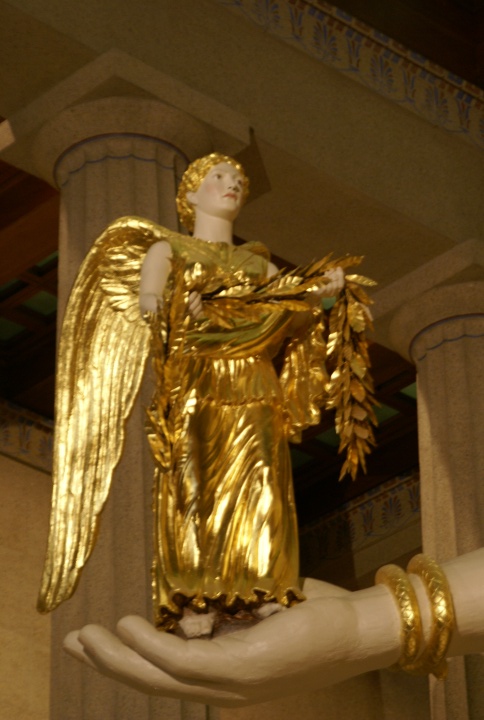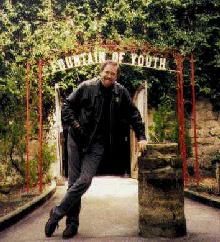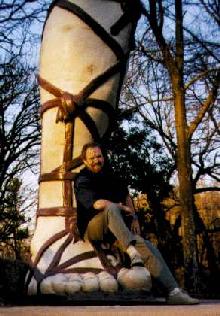
Alabama Postcard, February 1998
Story and Symbol Therapy Courses Register Community Dates Contact
Seminar Dates and Formats Articles Joseph Campbell Site Map Search

Hello Y'all -
This time, the call of the road inspired me to drive across the whole country to the comforts of the Southern states. As a devotee of the down-home cooking of that region, all grits and catfish and such -- and the lush landscapes in the balmy air, I was eager to get down South again.
Cruising through dusty Amarillo, Texas, I noticed an abundance of broadcast trucks crowned with satellite dishes. Oprah has come to town and it was clearly the event of the century. When the world descends on a regular town, it makes an impact.
 A true mythic encounter greeted me in Nashville where there is a full size replica of the Parthenon. The grand temple is in its full glory, not damaged like the original on the Acropolis above Athens. The Nashville version was built for an 1897 Exposition and contains a 42-foot statue of Athena -- a feature long missing from the original. The goddess of wisdom holds court in a massive space that does justice to her enormous grandeur. As the patron of elegance, she represents artistic and literary genius. She holds Nike, the god of victory, in her outstretched hand.
A true mythic encounter greeted me in Nashville where there is a full size replica of the Parthenon. The grand temple is in its full glory, not damaged like the original on the Acropolis above Athens. The Nashville version was built for an 1897 Exposition and contains a 42-foot statue of Athena -- a feature long missing from the original. The goddess of wisdom holds court in a massive space that does justice to her enormous grandeur. As the patron of elegance, she represents artistic and literary genius. She holds Nike, the god of victory, in her outstretched hand.
Since my expedition involved ideas and stories, it seemed propitious to honor this particular divinity early in the journey. After all, Athena accompanied Ulysses on his long odyssey -- and he returned home safely. Perhaps she would guide me through upcoming adventures.
The other temple in Nashville that required a pilgrimage was the Ryman Auditorium. Built as a Gospel Tabernacle in 1892, it was the original home of the Grand Old Opry. Once called the Carnegie Hall of the South, it became the mother church of country music. Exploring the steep balcony and cast iron stairways, I could get some sense of crowds just in from surrounding farms on hot Summer nights to hear Hank Williams or Patsy Cline. Elvis Presley was on the Opry only once -- and was not well received.
In Chattanooga, I got to visit my stepdaughter, Molly Stuart, who is now doing seminars that draw on her background as a law school professor. We compared notes on our experiences as circuit riders. She took me to see the remarkable city art museum overlooking the Tennessee River. Watching a couple of young men fishing from a small boat, my thoughts went to Huck Finn and Jim on their big adventure. Life on a river is certainly a timeless American literary image. The river valley that runs through the center of town is the jewel of Chattanooga. Molly said that people can boat in from as far as New Orleans and tie up right by the stadium to attend football games at the University of Tennessee campus.
In Atlanta, what I most wanted to see was the house where Margaret Mitchell wrote Gone With the Wind. The book was a project she started while recovering from something -- I think it was a badly sprained ankle. Her husband said there weren't any more books in the public library that she would like -- and that she'd just have to write one of her own. She drew on stories she heard as a child from her family and others who had lived through the civil war. She wrote in a tiny corner of a narrow little apartment that they affectionately called "The Dump." The dim, cramped space is a reminder that large endeavors can sometimes emerge from modest settings.
Heading due East, I followed the route of Sherman's heartless march to the sea and arrived in Savannah. This was a bustling seaport in the 1700s and the historic district dates from that era. My chances of becoming the Vamp of Savannah seemed limited. So, I settled for getting a picture of the slender old townhouse where Flannery O'Connor grew up and wrote the first of her short stories. That was long before she created such lively tales as "A Good Man is Hard to Find."
The long trailing fingers of the moss-draped oaks cast a gothic mood over the shady squares and venerable houses. I made my way to see the Bird Girl statue that graces the cover of Midnight in the Garden of Good and Evil There she stands, with her arms holding shallow little bowls in eternal welcome to the winged ones. The immense success of the book brought Savannah back to life and visitors want to pay their respects to the Bird Girl.
Tracing the coast Southward, I reached the oldest city in America, St. Augustine, Florida. The Spanish fortress at the mouth of the river is a genuine castle. Of course, the 400-year history of the place only celebrates the European heritage. There were older cities on this continent but that's another story. Anyway, I didn't go to the oldest house in the country, or the oldest store in the country, but I'm reasonably sure I had some of the oldest fast-food on record.

The main goal of my visit was to drink from the Fountain of Youth. This is the actual spring discovered by Ponce de Leon when he was searching for the secret of eternal vitality. Since I will be forever Young anyway, it seemed fitting to drink the fabled elixir. The spring is now inside an ivy-covered stone building. It gurgles amidst dioramas of Spanish explorers meeting native keepers of the waters. The water was foul-tasting, slightly brackish -- probably evidence that it is good for you. I feel Young as ever, so it must have worked.
Further south, and across to the Gulf coast, in Sarasota, I checked out the Ringling Museum. The circus wagons reminded me of the day I worked for the Clyde Beatty show setting up. I must have been all of twelve and all the boys earned their tickets by helping the carny types haul everything out of the big trucks and create the canvas theater. The elephants pulled the heavy ropes that lifted the bit top into place. Most of the day went into putting up chairs. Later, watching the famous lion tamer and the rest of the three-ring show was all the more exciting because I felt, for that day, that I was part of the circus.
One of the displays at the Ringling Museum was Zachinni's original cannon truck. This was the big gun that shot out the human cannon ball. As an impressionable youth, I thought that was the most amazing thing I had ever seen. There's an old story about the time the Great Zachinni went to the manager of the circus and wanted to quit. The boss begged him to stay, claiming he couldn't be replaced -- it would be impossible to find another man of his caliber.
In between tornadoes, my trek then threaded back up the center of the state to Cross Creek, the little hamlet where Marjorie Kinnan Rawlings wrote The Yearling. The simple wooden house is a virtual time capsule. It is just as it was when she was writing there in the thirties, and much as it was when a cracker family built it in the last century. It was on a sandy path then, not far from a lake, surrounded by orange trees. She was there hoping to capture the poor rural culture that was fast disappearing.
Rawlings based the yearling story on the real experience of a neighbor who, as a poor boy, treasured a young deer he had raised. The deer kept getting into the family's garden and eating what little they had to survive on. Finally, the boy had to kill his beloved pet. When the man told Rawlings the story years later he said it was the hardest thing he had to do in his whole life.
Further North, the itinerary veered up into the timlessness that is Alabama. In Montgomery, I found the dark shingled house where Zelda and F. Scott Fitzgerald lived while he was working on Tender is the Night. It is a museum now, with displays on their gilded life together. For a couple that served as symbols of the Jazz Age, they sure came to sad ends.
It took some looking to find Hank Williams grave. It is a grand monument put up by Hank Jr. with tributes to his father's poignant songs. For some reason, there were more seekers at this shrine than at the Fitzgerald House.
On up the road, Birmingham feels like the true heart of the South. I went to a killer play called For Whom the Southern Belle Tolls. It's a roaring parody of Tennessee Williams. It hit home partly because flirting with Southern Belles was making my visit particularly delightful. There is something truly enchanting about all that graciousness, but I digress.

The mythic surprise of Birmingham is an imposing statue of Vulcan, the god of the forge, guarding city like a sentinel on a mountaintop tower. The 53-foot sculpture was Birmingham's exhibit at the 1904 St. Louis World's Fair. Vulcan is an appropriate patron for an iron and steel town. He bears some kinship to Hepheastus, the divine blacksmith from Greece who inspires artisans and other industrious types. Here in the valley of the shadow of deadly fundamentalism, I relished finding a Pagan deity in a position of honor.
On the way back through Texas, I stopped in Austin. With a big river, surging springs, and abundant trees, Austin is a fresh, cool vision that is rare in these parts. It was good to see my 91 year-old Aunt Viola. Uncle Barney, the retired colonel, is still getting around fairly well. I love to get them talking about their courtship during the war in Hawaii where she was a nurse -- and about all the places they were posted over the years. We had time to remember visits with them in Germany and Turkey in my youth. Lives that include memorable places and experiences can make good conversation.
Then it was time to head home. I managed to miss the thorough washing that El Nino gave to California. The scenery on the way back to Santa Barbara, however, had grown much greener during my absence. It was not as densely green as the thick kudzu that drapes much of Alabama, but it was a reminder of the endless changes that keep on making this an interesting world to explore.
Jonathan